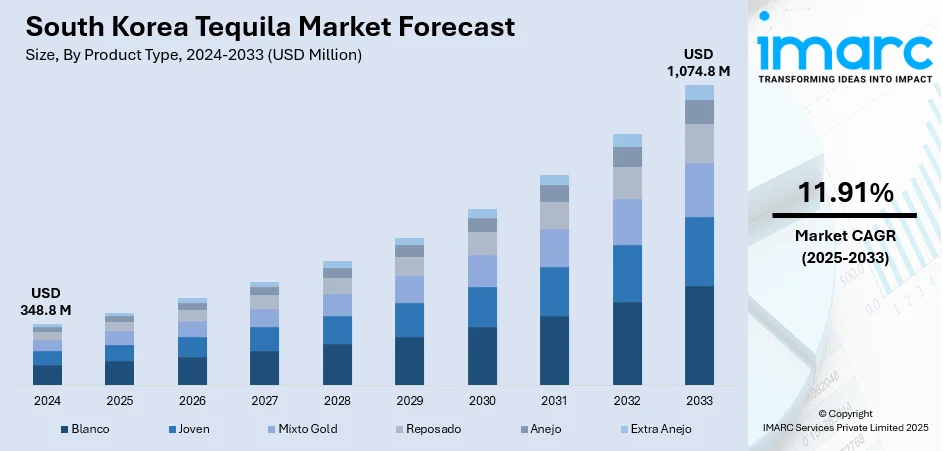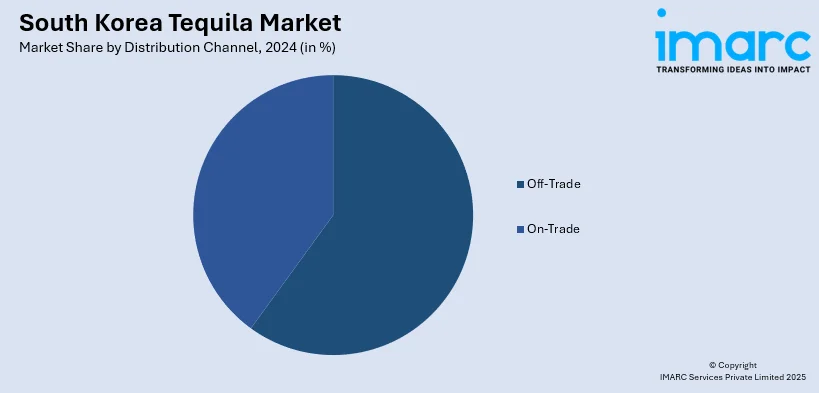
South Korea Tequila Market Size, Share, Trends and Forecast by Product Type, Purity, Price Range, Distribution Channel, and Region, 2025-2033
South Korea Tequila Market Overview:
The South Korea tequila market size reached USD 348.8 Million in 2024. The market is projected to reach USD 1,074.8 Million by 2033, exhibiting a growth rate (CAGR) of 11.91% during 2025-2033. The market is expanding rapidly, driven by increasing consumer interest in premium spirits and international drinking trends. The rising popularity of tequila-based cocktails and a shift toward high-quality aged tequilas are key drivers. Furthermore, this growth is significantly enhancing the South Korea tequila market share.
|
Report Attribute
|
Key Statistics
|
|---|---|
|
Base Year
|
2024
|
|
Forecast Years
|
2025-2033
|
|
Historical Years
|
2019-2024
|
| Market Size in 2024 | USD 348.8 Million |
| Market Forecast in 2033 | USD 1,074.8 Million |
| Market Growth Rate 2025-2033 | 11.91% |
South Korea Tequila Market Trends:
Rising Popularity of Tequila in South Korea
Tequila's expansion in South Korea has emerged as a thrilling trend in the nation's changing alcohol industry. The South Korea tequila market growth in the is driven by increased demand for premium and foreign spirits, particularly from young and city-based consumers. As more and more South Koreans look for variety in their drinking culture, tequila has increasingly turned out to be a popular choice. Moreover, individuals are learning about tequila as social media, as well as the growing cocktail trend, exposes them to tequila-based beverages like margaritas and palomas. In addition, high-end tequila brands are also spreading their reach in South Korea, making a broader array of tequila choices for the local consumers who increasingly seek the quality and authenticity of what they are consuming. This move away from the conventional local beverages such as soju towards more global choices reflects an intensifying urge to diversify drinking choices. With additional bars and restaurants adding tequila to their lists and marketing it as a high-end liquor, its popularity and popularity continue to increase in South Korea and help fuel the market's continued expansion in the next few years.

To get more information on this market, Request Sample
Shift Towards Premium Tequila Consumption
In recent years, there has been a clear shift towards premium tequila consumption in South Korea, marking a significant departure from the previous trends of low-cost, mass-produced varieties. The demand for higher-quality tequilas has surged, with consumers now seeking aged varieties such as Reposado and Anejo, known for their smooth, refined flavors. This shift can largely be attributed to increased consumer sophistication and a growing appreciation for fine spirits. The premiumization trend aligns with the wider global shift toward luxury and craft beverages, driven by consumers’ rising disposable incomes and a desire for more refined drinking experiences. South Korean drinkers are increasingly interested in the craftsmanship behind tequila production, leading to greater demand for artisanal and boutique brands that offer exceptional quality. Tequila is no longer just a party drink, but rather an elegant choice for sipping and savoring. This change is also reflected in the marketing efforts of tequila brands, which now emphasize the exclusivity and heritage of their products to attract the discerning South Korean consumer. As this trend grows, premium tequila is becoming an integral part of the South Korean market, indicating that the future of tequila in the region will be increasingly defined by high-end products and sophisticated consumption.
South Korea Tequila Market Segmentation:
IMARC Group provides an analysis of the key trends in each segment of the market, along with forecasts at the country and regional level for 2025-2033. Our report has categorized the market based on product type, purity, price range, and distribution channel.
Product Type Insights:
- Blanco
- Joven
- Mixto Gold
- Reposado
- Anejo
- Extra Anejo
The report has provided a detailed breakup and analysis of the market based on the product type. This includes blanco, joven, mixto gold, reposado, anejo, and extra anejo.
Purity Insights:
- 100% Tequila
- 60% Tequila
A detailed breakup and analysis of the market based on the purity have also been provided in the report. This includes 100% tequila and 60% tequila.
Price Range Insights:
- Premium Tequila
- Value Tequila
- Premium and Super Premium Tequila
- Ultra-Premium Tequila
The report has provided a detailed breakup and analysis of the market based on the price range. This includes premium tequila, value tequila, premium and super premium tequila, and ultra-premium tequila.
Distribution Channel Insights:

- Off-Trade
- Supermarkets and Hypermarkets
- Discount Stores
- Online Stores
- Others
- On-Trade
- Restaurants and Bars
- Liquor Stores
- Others
A detailed breakup and analysis of the market based on the distribution channel have also been provided in the report. This includes off-trade (supermarkets and hypermarkets, discount stores, online stores, and others) and on-trade (restaurants and bars, liquor stores, and others).
Regional Insights:
- Seoul Capital Area
- Yeongnam (Southeastern Region)
- Honam (Southwestern Region)
- Hoseo (Central Region)
- Others
The report has also provided a comprehensive analysis of all the major regional markets, which include Seoul Capital Area, Yeongnam (Southeastern Region), Honam (Southwestern Region), Hoseo (Central Region), and others.
Competitive Landscape:
The market research report has also provided a comprehensive analysis of the competitive landscape. Competitive analysis such as market structure, key player positioning, top winning strategies, competitive dashboard, and company evaluation quadrant has been covered in the report. Also, detailed profiles of all major companies have been provided.
South Korea Tequila Market News:
- July 2025: Choo Sung Hoon endorsed the premium Clase Azul tequila, boosting its popularity in South Korea. His YouTube video, featuring the high-end "Ultra" tequila, garnered millions of views, expanding the brand's reach and contributing to the growing demand for premium tequila in the Korean market.
- April 2025: Don Julio launched a limited-edition "Don Julio 194" in collaboration with global DJ Peggy Gou. The bottle, redesigned with unique mint green and deep purple colors, gained attention in South Korea, driving interest in premium tequila and expanding Don Julio's presence in the market.
South Korea Tequila Market Report Coverage:
| Report Features | Details |
|---|---|
| Base Year of the Analysis | 2024 |
| Historical Period | 2019-2024 |
| Forecast Period | 2025-2033 |
| Units | Million USD |
| Scope of the Report |
Exploration of Historical Trends and Market Outlook, Industry Catalysts and Challenges, Segment-Wise Historical and Future Market Assessment:
|
| Product Types Covered | Blanco, Joven, Mixto Gold, Reposado, Anejo, Extra Anejo |
| Purities Covered | 100% Tequila, 60% Tequila |
| Price Ranges Covered | Premium Tequila, Value Tequila, Premium and Super Premium Tequila, Ultra-Premium Tequila |
| Distribution Channels Covered |
|
| Regions Covered | Seoul Capital Area, Yeongnam (Southeastern Region), Honam (Southwestern Region), Hoseo (Central Region), Others |
| Customization Scope | 10% Free Customization |
| Post-Sale Analyst Support | 10-12 Weeks |
| Delivery Format | PDF and Excel through Email (We can also provide the editable version of the report in PPT/Word format on special request) |
Key Questions Answered in This Report:
- How has the South Korea tequila market performed so far and how will it perform in the coming years?
- What is the breakup of the South Korea tequila market on the basis of product type?
- What is the breakup of the South Korea tequila market on the basis of purity?
- What is the breakup of the South Korea tequila market on the basis of price range?
- What is the breakup of the South Korea tequila market on the basis of distribution channel?
- What is the breakup of the South Korea tequila market on the basis of region?
- What are the various stages in the value chain of the South Korea tequila market?
- What are the key driving factors and challenges in the South Korea tequila market?
- What is the structure of the South Korea tequila market and who are the key players?
- What is the degree of competition in the South Korea tequila market?
Key Benefits for Stakeholders:
- IMARC’s industry report offers a comprehensive quantitative analysis of various market segments, historical and current market trends, market forecasts, and dynamics of the South Korea tequila market from 2019-2033.
- The research report provides the latest information on the market drivers, challenges, and opportunities in the South Korea tequila market.
- Porter's Five Forces analysis assists stakeholders in assessing the impact of new entrants, competitive rivalry, supplier power, buyer power, and the threat of substitution. It helps stakeholders to analyze the level of competition within the South Korea tequila industry and its attractiveness.
- Competitive landscape allows stakeholders to understand their competitive product type and provides an insight into the current positions of key players in the market.
Need more help?
- Speak to our experienced analysts for insights on the current market scenarios.
- Include additional segments and countries to customize the report as per your requirement.
- Gain an unparalleled competitive advantage in your domain by understanding how to utilize the report and positively impacting your operations and revenue.
- For further assistance, please connect with our analysts.
 Request Customization
Request Customization
 Speak to an Analyst
Speak to an Analyst
 Request Brochure
Request Brochure
 Inquire Before Buying
Inquire Before Buying




.webp)




.webp)












